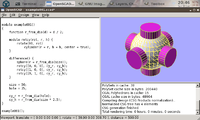Hello all,
I'm a long time Pandora owner, though I've found myself using it less and less for various reasons. I'm also founder of Bristol Braille Technology, which is a tiny start up not-for-profit making displays for blind people.
The one thing which has always been missing for me when trying to use the Pandora for work is the lack of CAD software. I have some pretty good CAD packages that I can emulate on DOSBox, but they don't cut it with compatibility & mouse control. Once upon a time compatibility wouldn't have been such an issue for me as I was pretty much working alone on my projects. But now BBT has gotten a bit bigger. There are real engineers working on it with me (I'm strictly an amateur in both senses of the word) & they've been making all our models in an amazing program called OpenSCAD.
OpenSCAD is based on a programming language. You don't edit the model directly, you recode it. Its both simple & very powerful. At the end is an example which draws an array of pins inside a block. It also has a clean interface; no cluter of menus & panels.
In other words, its very well suited to mechanical modelling on the Pandora, & would be indirectly helping us develop machines to improve literacy amongst blind & partially sighted people.
If someone can make a PND of OpenSCAD which is tailored for comfortable use on the Pandora---in other words, disable features it can't use, like OpenGL, make sure a few examples work OK & possibly put the editor & viewer in different windows so workspace is maximised--- then I'd be delighted to put in $40 of my own money as a starting bounty, & a thank you on the BBT web site to the porter. If this results in work being done on BBT projects from a Pandora where it otherwise wouldn't (which I expect it will) then BBT will match that bounty, albeit paid a little later.
Does anyone else have an interest in CAD? If so would you be willing to chip in too?
Thanks
Ed
I'm a long time Pandora owner, though I've found myself using it less and less for various reasons. I'm also founder of Bristol Braille Technology, which is a tiny start up not-for-profit making displays for blind people.
The one thing which has always been missing for me when trying to use the Pandora for work is the lack of CAD software. I have some pretty good CAD packages that I can emulate on DOSBox, but they don't cut it with compatibility & mouse control. Once upon a time compatibility wouldn't have been such an issue for me as I was pretty much working alone on my projects. But now BBT has gotten a bit bigger. There are real engineers working on it with me (I'm strictly an amateur in both senses of the word) & they've been making all our models in an amazing program called OpenSCAD.
OpenSCAD is based on a programming language. You don't edit the model directly, you recode it. Its both simple & very powerful. At the end is an example which draws an array of pins inside a block. It also has a clean interface; no cluter of menus & panels.
In other words, its very well suited to mechanical modelling on the Pandora, & would be indirectly helping us develop machines to improve literacy amongst blind & partially sighted people.
If someone can make a PND of OpenSCAD which is tailored for comfortable use on the Pandora---in other words, disable features it can't use, like OpenGL, make sure a few examples work OK & possibly put the editor & viewer in different windows so workspace is maximised--- then I'd be delighted to put in $40 of my own money as a starting bounty, & a thank you on the BBT web site to the porter. If this results in work being done on BBT projects from a Pandora where it otherwise wouldn't (which I expect it will) then BBT will match that bounty, albeit paid a little later.
Does anyone else have an interest in CAD? If so would you be willing to chip in too?
Thanks
Ed
radius = 0.7;
fn = 48;
min_height = 25;
block_width = 13;
for (i=[0:1:1]){
for (j=[0, 2.5, 6.5, 9]){
for (k=[0:1:2]){
pin(j, (i*block_width) + j, k*2.5);
}
}
translate([(i*block_width)-radius-1, -radius-1, 10]){
cube([block_width+(radius*2)+2, 8.4, 10]);
}
}
module pin(heightDiff, offsetX, offsetY){
translate([offsetX, offsetY, -heightDiff]) {
union() {
cylinder(h=min_height + heightDiff, r=radius, $fn=fn);
translate(v=[0, 0, min_height+heightDiff]) {
sphere(r=radius, $fn=fn);
}
}
}
}



